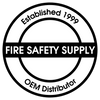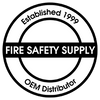Fire Safety Signage
Posted by the FSS Team on May 2nd 2024
Enhancing Safety Through Clear Communication
During emergencies like fires, clear and effective communication is of paramount importance. Fire safety signage serves as an essential tool in guiding occupants and visitors, facilitating safe evacuation, and mitigating potential hazards. In this article, we will delve into the significance of fire safety signage, the role it plays in emergency situations, and how its proper placement and design can make a difference in enhancing overall fire safety.
1. The Importance of Fire Safety Signage
Fire safety signage is a critical component of any comprehensive fire safety plan. These signs serve as visual cues that convey vital information, such as exit routes, fire extinguisher locations, and assembly points. Clear and prominent signage can mean the difference between a swift, organized evacuation and chaos during a fire emergency.
2. Types of Fire Safety Signs
There are various types of fire safety signs, each serving a specific purpose:
- Exit Signs: Clearly marked exit signs guide people towards safe escape routes during emergencies, ensuring a quick and efficient evacuation.
- Fire Extinguisher Signs: These signs indicate the locations of fire extinguishers, enabling individuals to locate and use them effectively to combat small fires.
- Fire Alarm Signs: Fire alarm signs inform occupants about the presence of fire alarm pull stations, encouraging immediate activation during a fire event.
- Fire Assembly Point Signs: These signs indicate designated assembly points where occupants should gather after evacuating, allowing for headcounts and ensuring everyone's safety.
3. Designing Clear and Effective Signs
The design of fire safety signage significantly impacts its ability to communicate information quickly and clearly. Here are some key design principles to follow:
- Readability: Use clear and bold fonts with high contrast colors to ensure readability, even in low-light conditions or smoke-filled environments.
- Symbols and Pictograms: Incorporate universally recognized symbols and pictograms to convey messages quickly, transcending language barriers.
- Arrows and Directional Cues: Include arrows and directional cues on exit signs to guide people towards the nearest safe exit route.
- Photoluminescent Materials: Consider using photoluminescent materials that glow in the dark to enhance visibility during power outages.
4. Proper Placement of Fire Safety Signs
Strategic placement of fire safety signs is crucial for their effectiveness. Here are some guidelines:
- Visibility: Ensure that signs are easily visible from various angles and distances, considering obstructions and sightlines.
- Eye Level: Place signs at eye level, so they are readily noticed, especially in crowded areas.
- Unobstructed Access: Keep signs unobstructed by furniture, decorations, or other objects that could block their visibility.
- Compliance with Regulations: Ensure that the signage complies with local fire safety codes and regulations.
5. Regular Maintenance and Inspections
Fire safety signs should be subject to regular maintenance and inspections. Faded, damaged, or missing signs should be promptly replaced to maintain their effectiveness during emergencies.
Fire safety signage plays a crucial role in guiding people to safety during fire emergencies. By focusing on clear communication, effective design, and proper placement, fire safety signage enhances overall fire safety measures. Investing in well-maintained and prominently displayed signs can make a significant difference in the event of a fire, ensuring the swift and safe evacuation of occupants and visitors.
 Since 1999, Fire Safety Supply has been the go-to for fire suppression products, industrial dry chemical systems, high and low-pressure CO2, vehicles, and clean agents. We serve various types of industries such as restaurants, commercial kitchen, wineries, and more.
Since 1999, Fire Safety Supply has been the go-to for fire suppression products, industrial dry chemical systems, high and low-pressure CO2, vehicles, and clean agents. We serve various types of industries such as restaurants, commercial kitchen, wineries, and more.
